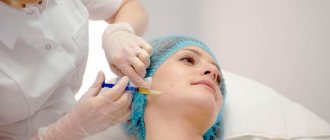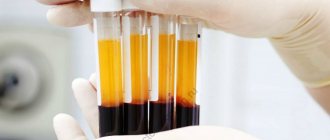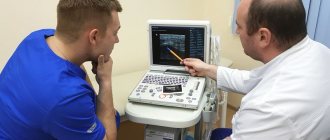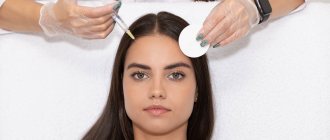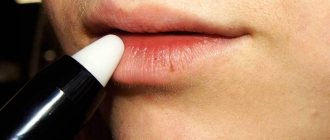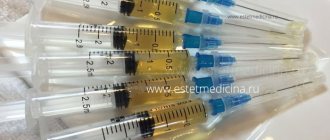Plasmolifting is the injection of platelet-rich plasma to stimulate tissue regeneration. Plasmolifting has been used for more than 20 years in maxillofacial surgery, dentistry, and traumatology to accelerate wound healing and treat atrophic skin conditions. Today, plasma lifting is widely used in cosmetology and aesthetic medicine in the treatment of acne and post-acne, hair loss, photo- and chronoaging, to enhance regeneration and reduce the rehabilitation period after laser resurfacing and chemical peels. The Plasmolifting method is universal and effective both in monotherapy and in complex treatment, and has a huge number of positive reviews not only in Russia, but also in many European countries.
Theoretical foundations of plasma lifting
The basis of the procedure is the intradermal injection of autoplasma. It is called the “elixir of youth”, containing a high concentration of growth factors (epidermal, platelet, transforming growth factors, vascular endothelial growth factor, fibroblasts, etc.), as well as hormones, enzymes and vitamins. It is growth factors that initiate the process of tissue regeneration and take an active part in it, naturally attract stem cells to the area of damage, stimulate their differentiation and division. This explains the pronounced rejuvenating and restorative effect. At the site of plasma injection, all restoration processes are activated, water balance and tissue respiration are normalized, the number of fibroblasts and their synthesis of collagen, elastin and intercellular substance increases. Clinically, this is manifested by leveling the skin texture, improving its texture and color, increasing turgor, reducing the severity of age spots, static and expression wrinkles, and tightening the oval of the face. The effect is noticeable after the first course of procedures and lasts up to two years. The result depends on the initial skin quality, general health and age of the patient.
Why is plasma lifting needed in neurology?
Class Clinic
Plasmolifting is a new method for neurology; it was introduced into practice relatively recently. The more interesting are the positive reviews from patients and doctors - there are more and more of them. What is this connected with? Anna Valerievna Penkova, a practicing neurologist at the Kaliningrad medical center Class Clinic, spoke about why plasma lifting turned out to be so effective in the treatment of neurological diseases.
How and why did plasma lifting appear in neurological practice?
The predecessor of plasmolifting was the well-known autohemotherapy. The patient was injected with his own blood, and the tissues began to recover much faster, the general condition improved, and the immune system was activated. Other effects also appeared, which are called vital, that is, increasing the vitality of the organism as a whole.
Subsequently, the method was improved by Professor Renat Akhmerov and Candidate of Medical Sciences Roman Zarudiy. For injections, instead of blood, they began to use plasma, free of erythrocytes and leukocytes, but saturated with platelets, it is also called platelet autoplasma (PAP).
Platelets contain protein factors that trigger cell repair processes. That is why they began to enrich plasma with them. This method was adopted in neurology as one of the ways to slow down degenerative processes.
The term “plasmolifting” itself consists of the words Plasma and Lifting (English - lifting), i.e. it implies stimulation of the regenerative potential of tissues.
Why exactly do platelets help accelerate regeneration?
It contains so-called growth factors. These are substances thanks to which the body launches regenerative processes:
IGF - insulin-like growth factor,
PDGF - platelet-derived growth factor,
EGF - epidermal growth factor,
FGF - fibroblast growth factor,
TGF-b - platelet-derived endothelial cell growth factor,
PTEGF - vascular endothelial growth factor,
PLGF -1|2: placental growth factors and thrombospondin (osteonectin, “culture shock protein”).
These growth factors trigger many regenerative mechanisms, for example, they activate the proliferation and migration of osteogenic cells, due to which bone tissue grows: the maturation of young cells accelerates, and bone tissue grows faster. Also, the described growth factors increase the production of collagen, hyaluronic acid and elastin, which are necessary for the creation of complete bone tissue, restoration of cartilage, muscle, nervous tissue, tendons and nerve fibers.
How is plasma lifting performed?
The procedure uses the patient’s own blood, which is centrifuged in special certified tubes with gel. In this way, plasma with platelets is separated from other blood elements. The resulting platelet autoplasma is used in the form of injections - injected into problem areas.
What clinical effects from plasma lifting are primarily noted by patients?
Anti-inflammatory effect - as a result of local stimulation of regenerative processes, the intensity of pain decreases, because the area and depth of lesions are reduced. By restoring the function of the spine and nerves, joint mobility increases.
For what neurological diseases is plasma lifting used?
For many: for the treatment and prevention of spinal diseases, for osteochondrosis, lumbago and intercostal neuralgia, protrusions and herniations of vertebral discs, tension headaches, pain in the cervical spine. In addition, the effective use of the method for cervical migraine and vertebral artery syndrome, ankylosing spondylitis has been noted. There are known cases of plasma lifting being used for compression fractures of the vertebrae, osteoporosis, and severe postural disorders (scoliosis and kyphoscoliosis).
The method can be used effectively both in the acute period and during remission, because one of its advantages is a local anti-inflammatory effect.
Are there any contraindications to the use of this method?
There are several contraindications, but they are relatively few: systemic blood diseases, tumors, acute infections and allergies to heparin. For other patients, the method is safe; it can be effectively combined with massage, acupuncture and drug treatment.
Is it possible to compare what is more effective for neurological diseases - medications or plasma lifting?
Therapy using plasmolifting is rarely used as the only method of treatment; as a rule, this method is prescribed along with drug therapy. It is safe to say that with complex treatment, positive results and recovery with plasma lifting occur faster than without it.
It also happens that plasma lifting is prescribed as an alternative method in situations where there are contraindications to the use of pharmacological agents. In such cases, it is possible to evaluate the effectiveness of plasma lifting on a par with drug therapy; this is done by a neurologist based on the results of treatment.
Make an appointment with Anna Valerievna Penkova on the website or by phone.
The main stages of the facial plasma lifting procedure
Stage 1. We draw blood from a vein into a certified tube. High-quality, highly purified plasma can have a therapeutic effect. Such plasma can only be obtained using test tubes designed specifically for plasma lifting and which have passed clinical trials and certification. The tubes contain highly purified sodium heparin in a minimal dosage, which does not have any negative effects on the human body after its administration.
The tubes also contain a gel, which during centrifugation adsorbs red blood cells and fatty acids, allowing one to obtain highly purified plasma.
Stage 2. We isolate platelet plasma from the blood by centrifugation. A necessary step in creating highly purified plasma is compliance with the centrifugation regime. Only at a certain centrifuge rotation speed is a therapeutic concentration of platelets created.
Stage 3. We inject plasma. Depending on the injection zone, the papular technique or nappage is used.
Combination of facial plasmolifting with cosmetic procedures
Plasmolifting can be combined with any cosmetic procedures. The use of plasma lifting in complex programs for the correction of cosmetic skin imperfections allows you to achieve more pronounced results in the shortest possible time.
Plasmolifting of the face and photorejuvenation - procedures are perfectly combined within one course for the correction of rosacea and hyperpigmentation. The interval between procedures must be at least 7 days.
Plasmolifting and RF lifting - the combination of these procedures within one course is especially indicated for fine-wrinkled type of aging. Procedures alternate with an interval of 1 week.
Plasmolifting and Botox or Dysport - it should be remembered that due to the pronounced regenerative effect of autoplasma, reinnervation is accelerated, which leads to a decrease in the duration of action of botulinum toxin. Therefore, it is recommended to carry out a course of plasma lifting, and after 2 weeks correct expression wrinkles using Botox or Dysport.
Plasmolifting of the face and contouring of the face - to improve the quality of the skin, a course of plasmolifting is carried out, and after 10-14 days, nasolabial folds and other problem areas are corrected with stabilized hyaluronic acid. After the contouring procedure, plasma lifting procedures are carried out after 2-3 weeks.
Plasmolifting and biorevitalization / facial mesotherapy are complementary procedures, therefore they are often used in the same program.
Plasmolifting and mesothreads - mesothreads are placed 7 - 14 days after the course of plasmolifting.
Plasmolifting is a rejuvenation procedure
I am the developer of the plasmolifting technique - a unique non-surgical rejuvenation technique.
This topic is more than close to me, since I am the developer of the Dr. Renat Akhmerov® Plasmolifting method - a modern and more effective development of well-known prp methods (prp - platelet reached plasma or platelet-rich plasma). On my personal professional website, I try to convey all aspects of this technology to patients and colleagues.
Plasmolifting ( examples of procedure results ) is a unique method of non-surgical facial rejuvenation, based on the use of the patient’s own plasma. This method of “self-rejuvenation” is based on the restorative effect of platelet-rich plasma (PRP), which is injected into problem areas and activates the functioning of connective tissue cells. As a result, using the body’s own reserves, the biological mechanism of natural skin rejuvenation is launched without surgical intervention or other drastic measures. This technique has been approved and registered by the Russian Ministry of Health and is actively used in leading cosmetology clinics not only in our country, but also abroad.
What are the mechanisms of plasma lifting?
Over time, the processes of cell regeneration and metabolism slow down, which contributes to the gradual withering of the skin. Cell renewal mechanisms need to be restarted to stop the aging process. Human blood (plasma) contains all the necessary elements for the normal functioning of cells and the body as a whole, as well as its own renewal mechanisms. It is known that the biostimulating properties of blood are noticeably activated with a significant increase in the concentration of platelets in plasma. Platelets contain regulatory molecules that ensure tissue regeneration when they are damaged and when cell activity fades.
After administering platelet-rich plasma (PRP) to the patient, connective tissue cells (fibroblasts) located in the deep layers begin to synthesize collagen, elastin and hyaluronic acid, which are responsible for the smoothness and elasticity of the skin. Along with this, the matrix of the dermal layer is restored and stimulation of skin macrophages begins to destroy excess melanin. Thus, the procedure is based on the mechanism of activating one’s own connective tissue cells through one’s own plasma. As a result, it is possible to achieve a rejuvenation effect that is incomparable with traditional methods.
Indications for the procedure
The procedure ( reviews of the procedure ) can be performed by people at any age, when age-related changes in facial skin become noticeable and cosmetic defects appear. Typically, the first signs of skin aging begin to appear after 30-35 years.
The procedure is recommended in the following cases:
– Age-related changes in the fibers of the connective tissues of the skin (elastosis) – Reduced skin turgor – Dryness and flaking – The appearance of the first small wrinkles – Initial manifestations of ptosis of the tissues of the face and neck – Formation of skin stretch marks due to sudden weight loss – Strong ultraviolet irradiation of the skin – Rehabilitation of the skin after peeling (laser or chemical) – Inflammation of the sebaceous glands (acne) – Hair loss.
Contraindications:
The procedure is not carried out if:
– severe diseases of internal organs; – systemic blood diseases; – pregnancy; – immunosuppressive conditions; – mental disorders.
How is the procedure done?
The day before taking a biochemical blood test, it is necessary to exclude fatty and fried foods from the diet, as well as foods with a high content of preservatives. 4 hours before the procedure, it is recommended to refrain from eating and limit yourself to drinking plenty of fluids.
In leading clinics, the entire procedure is carried out only on certified equipment. To obtain platelet-rich plasma (PRP), intended for subcutaneous and intradermal injections, blood is taken from the patient into a special tube for Plasmolifting. The procedure is absolutely safe and does not cause severe pain - in fact, taking blood is similar to taking a regular intravenous test. At the next stage, the blood is purified and placed in a special centrifuge, where it is divided into three fractions: platelet-poor plasma (PRP), platelet-rich plasma (PRP) and red blood cells. The fraction most enriched in activated platelets (APT) is selected. A special feature of the technology is the ability to obtain plasma with a platelet concentration of up to 950-1200 thousand cells per 1 ml of plasma at room temperature. The process of obtaining medicinal drugs is automated and takes about 15 minutes.
Next, the resulting plasma is immediately injected into the patient’s dermis according to a certain scheme. After plasma is introduced into the reticular layer, active fibroblasts are located along the lines of natural age-related stretching (Langer's lines). As a result of the production of new collagen and elastin fibers, natural skin tightening occurs. If during plasmolifting plasma is administered according to the principle of mesotherapy, that is, no deeper than the papillary layer of the dermis, then the production of hyaluronic acid is activated to a greater extent. The procedure itself takes about an hour and does not require pain relief (local anesthesia is possible if necessary).
Results of the procedure
Changes become noticeable after the first procedure, but to obtain the effect of whitened, smooth skin, it is recommended to undergo 2-3 procedures throughout the year at intervals of 6 months. The result is natural skin rejuvenation - increased elasticity, elimination of dark circles under the eyes, folds and wrinkles, including “mesh” wrinkles, as well as slowing down skin aging, normalizing its moisture and improving complexion. In terms of external manifestations, the results of the procedure are similar to superficial surgical face lifting, but the advantage is the complete absence of surgical intervention. One of the noticeable results of the procedure is “porcelain skin” - smooth, velvety and as if glowing from the inside. The effect depends on the condition of the skin, the patient’s age and other factors, but in total the result can last for 1-1.5 years.
Safety guaranteed!
Platelet-rich plasma (PRP) may require 20 to 100 ml of blood. Taking even 100 ml does not pose a danger to humans and does not lead to any dysfunction of internal organs. Moreover, this promotes more active functioning of the hematopoietic system. The patient’s own blood is injected into the dermis, thus eliminating the possibility of allergic reactions or rejection. Platelet-rich plasma is also safe from the point of view of transmitting dangerous infections, which cannot be guaranteed when administering platelets from donor blood. The fundamental advantage of the procedure is the absence of a rehabilitation period. After the procedure, small bruises may remain at the sites of multiple injections, which quickly disappear.
Combination with other procedures
The procedure can be combined with cosmetic procedures such as laser photothermolysis, laser hyaluroplasty or a combination laser. Laser hyaluroplasty allows you to prepare the skin to increase the content of hyaluronic acid, laser photothermolysis consolidates the result of the procedure, and a combined laser enhances the rejuvenation effect.
You can find out about the price of my services by coming to my appointment or writing to me: [email protected]
